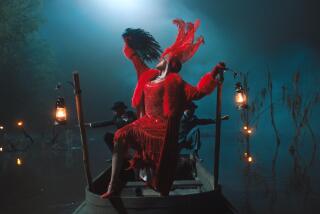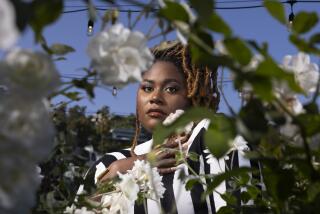Blazing heat, rain and so much mud — it was all a gift to ‘Mudbound’s’ costume designer
Director Dee Rees’ potent and beautiful drama, “Mudbound,” is set in the racially strident rural South during World War II and stars Carey Mulligan (as Laura McAllan) and singer Mary J. Blige (Florence Jackson), among a sprawling cast. The film is based on Hillary Jordan’s 2008 award-winning novel of the same name, and showcases a poverty-filled, mud-soaked Mississippi Delta farm and the people – both black and white – forced to eke out a living amid the suffocating Jim Crow era.
“When you get a gift like this film it’s not a job,” says costume designer Michael T. Boyd, who previously worked with Rees on her Emmy-winning HBO film “Bessie.” “Yes, it pays the bills, etc., but it’s really more about how are you going to utilize this opportunity, this trust? ‘So do it right,’ I told myself.” He adds: “Doesn’t mean you can’t have fun along the way, though.”
The weather – the heat, rain and especially all the mud – seem almost another full character in the film. How did these affect your costume designs?
It was oppressive – both in real life and on-screen. I remember being on set one day [in Louisiana] and almost being able to taste the heat, it was so hot. The real-life weather meant we had to have many multiples of everything and we did a lot of aging of the clothes.
And this is the way I thought about the weather inside the film: That heat, that rain, mud, that land -- it almost sucks everyone in physically. It’s like a vacuum sucking all their beings into it. Any chance for elegance or civilization pretty much is gone. That being said, a part of the [designing] was being careful not to have the color itself sucked out of everything, otherwise you’d mostly have sepia tones and it would be totally uninteresting screen-wise that way. You can mute and drab something and still have color.
Looking at the film’s clothing it almost looks like the period is 1930s rather than the mid-to-late ’40s. Why?
I’m glad you noticed that. Sometimes people think, ‘OK, we’re doing something in the ‘40s and ‘50s and the fashion has to match.’ But that’s not always true. For certain segments of society it’s very much back-dated when it comes to period fashion. The poorer you were, the more time-warped you looked. In this film, you could even wear clothes from the ‘20s and it would look real. These people were so poor and lived at a time when they passed clothes down multi-generations; grandmother to mother to daughter; a world away from today.
The film has two very fashion-forward actresses in real life -- Carey Mulligan and Mary J. Blige -- both who care about and love modern fashion. How did they react to being costumed so plainly?
With Carey, I knew from the first day she walked in for the first fitting we were on the same page, totally. She has a lot of changes and everything just seemed to work. With Mary, her wardrobe and look in real life is so far removed from what she is on-screen and this experience was so different for her. I give her a lot of credit because that’s a scary thing to do when you’re not used to that process [of acting and character transformation]: ‘OK, I’m going to wear that?’ someone might think.
But there was never any ‘I don’t like that,’ from either. When Mary tried the clothes on I guess if I were focused on looking I might have been able to see some discomfort, a little nervousness or a little unsureness because this was new ground for her. Yet she did her job and look at what the benefit is because she allowed herself to go that route.
Jonathan Banks’ Pappy McAllan was an utterly irredeemable ugly racist character. When you costume such a part, are there any special tricks used?
Not in this film. I think it almost would have been a distraction; if I tried to make him look different than his station in life, it would have looked odd. I just tried to make him look as real as possible so the evil of the character can come out by itself. I mean whether he’s in a barrel or suspenders or a tuxedo suit his reprehensible soul would have been apparent.
The KKK costumes for that dramatic and violent barn scene: Did you decide those by region and time period? I understand KKK regalia has many variations across those two planes.
Yes, that’s correct. I sat down with Dee one day and we discussed just that scene and we decided to do a mixture; the poorer men with the feed bag-looking hoods with the eyes cut out and tied with a string and others with the full Klan regalia. And I think it served us well.
I don’t think it would have been as powerful a scene if I would have had them all dress in white robes. It’s somehow more real and intimate; this wasn’t a parade or a burning-cross meeting for show but pure intimate violence and I think the mixture added texture to the event. It allows the horrid evil of these people, their neighbors, to show.
Were the military costumes exact replicas, especially the Black Panthers’ uniform? They were pretty fabulous.
Yes, absolutely. Some people might say, ‘Oh, it’s just a uniform, put it on and here we go.’ But to me it’s as important as the color of Carey’s dress in that big Memphis party soiree scene [a navy blue silk]. The uniforms are very accurate. I had the Panthers’ patch made as I doubt you could find one today in good enough condition to use. The other pilot uniforms were also replicas; it’s something I’m a stickler on. I just recently finished “The Long Road Home” about Afghanistan and there was a military consultant on set who would measure and correct something an eighth of an inch off. I’m not that exact, but pretty close!
See the most read stories this hour »
More to Read
From the Oscars to the Emmys.
Get the Envelope newsletter for exclusive awards season coverage, behind-the-scenes stories from the Envelope podcast and columnist Glenn Whipp’s must-read analysis.
You may occasionally receive promotional content from the Los Angeles Times.






